|
|
| |
instep
exclusive
Peshawar fashion: Peeping out from behind
the veil
Contrary to what you might think, there is a fashion scene blossoming
in Peshawar. Instep explores style in the most misunderstood and
underestimated city of Pakistan
By Maria Tirmizi |
| |
Nabeela
is a 35-year-old mother of two: a ten-year-old daughter and a nine-year-old
son. Her hazel eyes, with just a touch of grey, and clear, ivory complexion
speak of her Pathan ethnicity, yet she speaks in a soft, monotonic
voice without a hint of a Pushto accent and the professionalism of
a car salesman closing in on a Benz deal. Born and raised in Wah (she
explains the discrepancy), Nabeela moved to Peshawar some 13 years
ago after getting married in a liberal-minded Pathan family from Karachi.
The city initially felt alien to her. She didn't socialize much. But
there was something that she possessed that would in time guarantee
an affiliation with over half the women in Peshawar --her little cardboard
box filled with tiny dresses she stitched as a child, speaking of
a passion for fashion designing which would one day blossom into a
lucrative business setup.
|
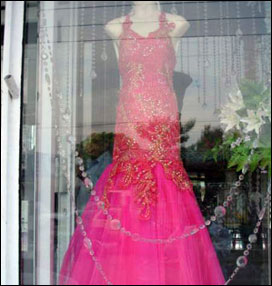 |
| |
Precisely
9 years ago, she embarked on a small, home-based fashion designing
career under the brand name Simones--after her daughter. Word spreads
like wild fire in a city like Peshawar--something that can go as much
against a woman as for her. In Nabeela's case, it significantly boosted
her business and with her modest force of 35 skilled workers behind
her, she now claims to have a clientele of approximately 75 percent
of women in Peshawar, with many even coming in from Charsadda, Nowshera
and Kohat. She has one outlet of her ready-to-wear casual/semi-formal
clothes in the main city and another small one inside her home where
she meets with clients and takes orders for bridals and formal wear.
But with a hoard of home-based, self-proclaimed designers in every
street and alley in Peshawar, what sets Nabeela apart? |
| |
Apparently,
something quite significant.
She is the only female fashion designer willing to advertise and promote
herself.
Nabeela is fortunate to have a domestic support system that does not
discourage a woman's right to independently exert her talent and ambitions.
She experiences no hang-ups or fears about publicity that is acquired
not only through the respectable word-of-mouth avenue, but also through
billboards and local cable channels---an approach that no doubt provokes
frowns and disapproval of the husbands of other designers. |
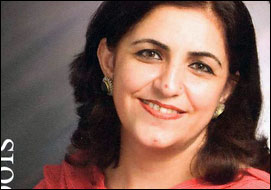 |
| |
| "I
owe a great deal to my liberal minded in-laws and husband. From financial
to moral support, my husband has always been with me every step of
the way. You know, there are many issues and responsibilities a housewife
faces and it can get very challenging to manage a business simultaneously.
But he gives me breathing space. During wedding season I've worked
till 3 to 4 am and he has always supported me." |
| |
"So
he's different from the rest," she adds with a meaningful laugh.
Peshawar may epitomize North-western conservatism. It may appear to
reside in its own little bubble of traditions and values that many
from outside don't quite understand. Young girls from Lahore or Karachi
may balk at the possibility of visiting the city, let alone living
there.
But there are many intelligent, beautiful, well-dressed women, born
and bred in Peshawar, who are quite content in their bubble and do
not understand the hype about 'scary, conservative Peshawar'. They
talk to Instep and comment on the bustling, at times fiendish, fashion
scene in the city that guarantees that a designer like Nabeela, who
keeps her prices limited for the average woman, does remarkably well.
One thing they all agree on. Peshawar is rich, colourful and fashion-savvy,
regardless of what outsiders feel. And it is promising enough to beckon
more designers from outside, pending the flippant policies of the
local government. |
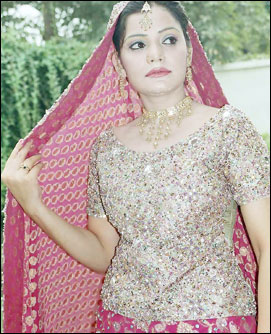 |
| |
WITH
CASH IN HAND, OUT-OF-CITY DESIGNGERS ARE THE REAL RAGE
"I have noticed one thing about fashion in Peshawar," muses
Aiman, a 25-year-old girl from an upper class bureaucratic family
of the city. "The more inaccessible your designer is, the trendier
it is to wear his/her clothes.
"There was a time women used to boast about getting their clothes
made from Islamabad. But now Islamabad seems so nearby, so it's more
fashionable to brag about Lahore and Karachi."
Hence, while the larger bracket of women in Peshawar are more than
happy to opt for Nabeela, since her bridals do not exceed 80,000 rupees
and her ready-to-wear range is between 1200 rupees to 5000 rupees,
it is the small section of the rich and spendthrifts who wouldn't
even hear of it! For them, it has to be Umar Sayeed or Nilofer Shahid
or HSY or, well, you get the picture.
|
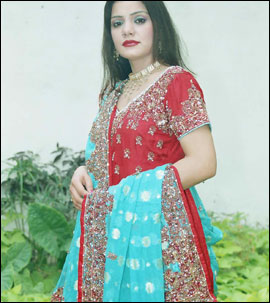 |
| |
"I
have yet to see a bridal dress at any close friend's wedding that
has been made in Peshawar. And if I do come across any such dress,
it is screaming that it's been made here," laughs Aiman.
Another girl in her twenties, Palwasha, also from an upper class family
of Peshawar says, "Apart from the charm of a flashy, expensive
label that makes girls choose Umar Sayeed over a Peshawar designer
is the fact that local designers are not doing anything innovative.
They're all making stuff inspired by Lahore and Karachi, user cheaper
imitations. Designers from Peshawar can't really put themselves on
the map, especially outside the city, if there is nothing different
or exciting about their work." |
| |
Ask
Nabeela what concepts she utilizes in her clothes, and she mentions
resham threadwork with a touch of sequins and beads, kora, wasli etc.,
on chiffons, khadis, silks and jamawars--all that has been done to
death all over the country. She even accepts that she shops in Lahore
a lot for ideas and materials.
But she defends that by saying, ""I can't differentiate
my clothes from others because all over Pakistan, you see people following
a similar fashion streak of cuts and patterns, whether it's western
or traditional. And people here do want me to follow those trends.
So I would say that Lahore and Karachi might have mega huge designers
but Peshawar is also not far behind. If my work isn't a whole lot
better than them, then it is at least not any lesser as well." |
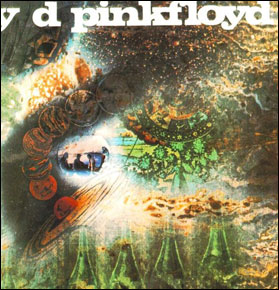 |
| |
She
also doesn't consider out-of-city designers competition precisely
because they are so very expensive and not for the larger market.
Another 19-year-old girl who goes to Nabeela --not for bridals, she
insists, but for formal wear that she urgently needs for a wedding---says
that she usually takes a magazine and asks her to copy a certain design
for her. And Nabeela accepts that she is more than willing to accommodate
such clients. |
| |
FABRIC
CRAZE VERSUS DESIGNGERS
No one is oblivious to the fact that there is a huge market of imported
fabric in a wide variety of colours, patterns and materials in the
bazaars of Peshawar; hence an obsession with clothes exists.
Foreign material--cheap and expensive, synthetic and pure--comes in
from China, Thailand and Korea in Peshawar's Koochi Bazaars and keeps
women, many even from Punjab, shopping till they drop.
One college-going girl informed Instep that it is almost unthinkable
for her to repeat clothes she has worn once. With Swiss voiles, chiffons,
georgette and silks so readily available at such reasonable prices,
many households prefer to keep sending a constant stream of fabric
to family tailors.
"What do you expect when you see so much fabric since your childhood?
You get used to it," said the young girl.
|
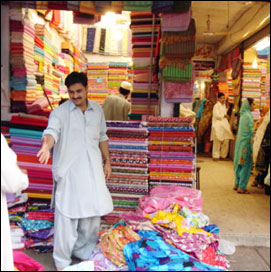 |
| |
Sundus,
a young mother of two from a well-established family of Peshawar adds,
"There aren't a lot of extra curricular activities in Peshawar.
So you go out for shopping. And what do you shop for? Shoes and bags
aren't all that great here so you get them from elsewhere. One outlet
remaining and that is shopping for fabric."
Competing with Koochi bazaar, you find Bareeze, Arooshe, Junaid Jamshed,
Al Karam Lawns, and exhibitions of Yasir Waheed, that manage to do
spectacularly well as well. |
| |
Sami,
manager of a Yasir Waheed outlet in Lahore says, "We've had two
exhibitions in Peshawar and the response has been amazing both times.
They keep calling us for more exhibitions as well but we haven't gone
back yet. Actually, we faced some problems in Islamabad. On the day
of our exhibition in the capital, the authorities sealed the area
around the hotel for some security reasons and people could not show
up. Politics affects business everywhere, including Peshawar so we
can't take the risk just yet, despite the fact that people in Peshawar
are really into shopping and have been asking us to come back a lot."
With so much fabric available, girls have gotten used to experimenting
with it themselves, rather than going to a boutique or a local designer--especially
since many feel that boutique fabric isn't of the best quality. Generation,
Reet and Chen One exist in the city with their reasonably priced clothes,
but they aren't really the rage. |
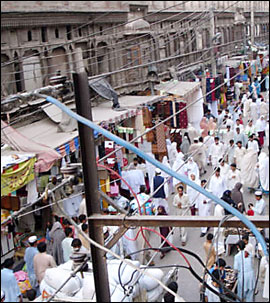 |
| |
But fabric craze aside, women say that their pockets, rather their
husbands', are large enough to accommodate real, fashion icons in
the city. Currently, no boutique of any famous designer is available,
though Sobia Nazir does plan to set up an outlet there.
Girls insist that it is high time big, exciting names come to the
city.
"People are ridiculously crazy about clothes here. It'll be
strange if big designers don't eventually open up their boutiques,"
said Sundus.
ALL
DRESSED UP AND NOWHERE TO GO?
Street fashion is an alien concept in Peshawar's chaddar-clad markets.
Hence, women are more into formal wear that they can actually show
off at weddings and grand tea parties.
"You can go outside wearing anything unfashionable hidden under
your chaddar. It's only at weddings, school/college functions and
parties organized for ladies that you pay some attention to your
wardrobe. And it is then that you notice that girls are very much
into dressing up, wearing anything from capris to sleeveless, though
only a small section of girls wear sleeveless because most families
are traditional," says Nabeela.
In universities, women tend to cover their heads, with active Jamaat-e-Islami
student bodies on campus, but in buildings off the main campus,
you would find girls dressed up without a dupatta on their heads,
some even in capris, sleeveless, fashionable tunic kameezes etc.
And they do look quite modern and chic. It was another time when
travel-weary, hackneyed fashion reached the tailors of Peshawar
after girls in Lahore were so-over-it. Now, television and magazines
have made it easier for girls in NWFP to follow the same trends
at the same time in Lahore, Karachi and Islamabad.
There is another social gathering that has significant importance---funerals.
It is here that women from all over town, however remotely familiar
with the deceased, gather and offer their tribute so as to not offend
the bereaved family with their absence. And it is then that they
steal glances at each other's designer lawns over their rosaries.
CAN
PESHAWAR FASHION OFFER SOMETHING DIFFERENT?
A young girl was getting married in Peshawar last year. She decided
to order most of her formal wear, including her bridal dress from
Karachi and Lahore. But there was something she craved for that
could only be found in Peshawar ---Afghani embroidery.
"It's very very fine resham threadwork, done on a special cloth
and it takes ages to finish. It's so fine that you can actually
count the boxes of the weave. You normally find such embroidery
on the neck and sleeves of Afghan men's garments and on Afghan women's
chaddars," she explains, going on to add that the embroidery
came to Peshawar through Afghan refugee camps.
"But most women who are skilled at it have left the country
so I was really disappointed when I couldn't get it done,"
she added.
Even Nabeela has tried to incorporate afghan embroidery in her clothes,
which points at the importance of the work of craftsmen in boosting
local, ethnic fashion and saving it from mundane copy work.
Apart from embroideries, Nabeela experiments with ethnic velvet
peshwas and kochi dresses as well, which might look spectacular
with a bit of interesting fusions and alterations.
THE
'AFGHAN' GOWNS
Visitors are often surprised to find clothing store windows boasting
stylish, glossy, western gowns behind the stream of covered heads
and beards passing by. Such dresses are mostly worn by Afghani women
on their weddings and engagement functions. Starting from 4000 rupees,
they go up to 20,000 rupees and are popular even among the non-Afghan
population.
Abdul Mateen, a 22-year-old Afghani, moved to Peshawar as a toddler.
His father owned a large store of wedding gowns in Afghanistan,
which he shifted to Peshawar some twenty years back. Zalmay, Abdul
Mateen's partner and of the same age, moved to Pakistan when he
was 11. Zalmay informs Instep in extremely broken Urdu that his
father used to be a Major in Afghanistan.
"He had many men reporting to him," he said with endearing
child-like enthusiasm. "It was a blessing."
"But I'm happy here too," he quickly adds, "business
is doing well."
Abdul Mateen and Zalmay own the biggest Afghan wedding gowns store
in Peshawar, called Jashan-e-Uroos.
They use materials like silks, chiffons and tissue, and utilize
their own Afghani designers and some Chinese-inspired designs.
"You can tell Afghan women apart on the street. They wear long
dresses with trousers, mermaid full length skirts, with chaddars
on their heads. Locals, on the other hand, are seen in shalwar kameezes
and chaddars," informed Palwasha.
IS PESHAWAR
AS CONSERVATIVE AS WE THINK
"Strict?" a hefty, middle aged man who works at a women's
fabric store exclaimed in a friendly manner with a heavy Pushto
accent, "It's a total misconception. We're not strict people
at all!" He shrugs as if the notion is ridiculous.
But of course, they are a traditional and conservative people.
One particular home-based designer told Instep that she would ask
her husband if it was okay to speak to Instep about her designing
'hobby'.
She apologized beforehand if she would be unable to call back, explaining
politely that it's not really nice to advertise because of the traditional
environment in Peshawar. And she never did call back.
"I don't know why they feel this way," says Nabeela. "They
probably have restrictions from home."
Nabeela hasn't done any fashion shows. There are no professional
models available and government policies aren't exactly catwalk-friendly.
On a private basis, shows can be arranged in universities though
and she did try doing that once.
"I tried approaching some young designers for a joint fashion
show. I had thought of a proper mehndi/barat/walima theme but they
didn't give a positive response. Probably restrictions from home
again," she guessed.
But asking her about the most pressing difficulties she faces as
a fashion designer operating in Peshawar, Nabeela says the only
issues are related to non-availability of skilled labour.
According to her, everything else is A-okay
.
"Girls here are very aware of the world around them and are
quite modern. Iqra Fashion Institute in Peshawar is churning out
young, ambitious designers every year. Things are progressing. We
call the world a global village, so how can we even think that Peshawar
is far behind?" Nabeela asks.
"But we are also very traditional," she adds importantly.
"We have some values. And we try not to cross them." |
| |
|

